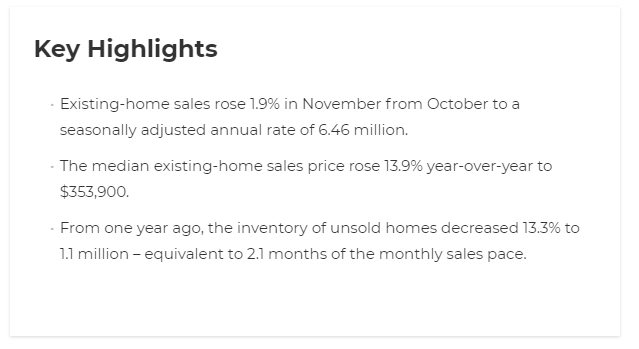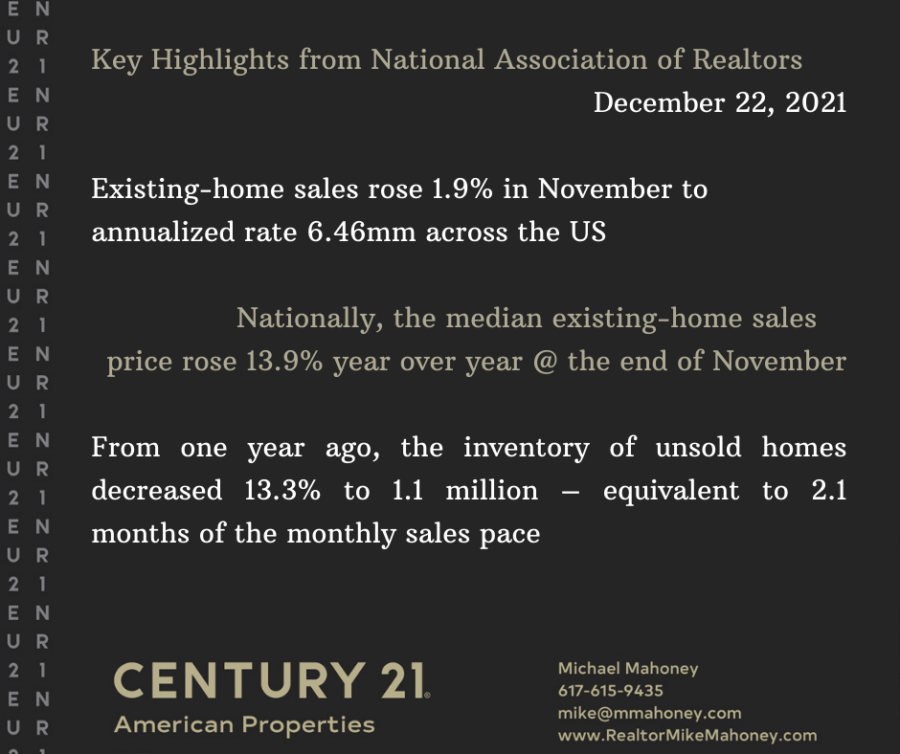WASHINGTON (December 22, 2021) – Existing-home sales rose in November, denoting three consecutive months of increases, according to the National Association of Realtors®. Three of the four major U.S. regions reported growth in monthly sales, while the fourth region held steady in November. From a year-over-year perspective, only one region experienced a rise in sales as the three others saw home sales decline.
This report is from the National Association of Realtors

Total existing-home sales,1 https://www.nar.realtor/existing-home-sales, completed transactions that include single-family homes, townhomes, condominiums and co-ops, grew 1.9% from October to a seasonally adjusted annual rate of 6.46 million in November. Sales fell 2.0% from a year ago (6.59 million in November 2020).
“Determined buyers were able to land housing before mortgage rates rise further in the coming months,” said Lawrence Yun, NAR’s chief economist. “Locking in a constant and firm mortgage payment motivated many consumers who grew weary of escalating rents over the last year.
“Mortgage rates are projected to jump in 2022, however, I don’t expect the imminent increase to be overly dramatic.”
Yun forecasts the 30-year fixed mortgage rate to average at 3.7% by year-end of 2022.
Total housing inventory2 at the end of November amounted to 1.11 million units, down 9.8% from October and down 13.3% from one year ago (1.28 million). Unsold inventory sits at a 2.1-month supply at the current sales pace, a decline from both the prior month and from one year ago.
The median existing-home price3 for all housing types in November was $353,900, up 13.9% from November 2020 ($310,800), as prices increased in each region, with the highest pace of appreciation in the South region. This marks 117 straight months of year-over-year increases, the longest-running streak on record.
“Supply-chain disruptions for building new homes and labor shortages have hindered bringing more inventory to the market,” said Yun. “Therefore, housing prices continue to march higher due to the near record-low supply levels.”
Yun noted that inflation and the pace of price appreciation is expected to subside next year. Last week, NAR held its third annual Real Estate Forecast Summit, featuring economists and housing experts whose consensus found inflation would likely ease in 2022 at a 4% rate, while home prices are expected to rise at a moderate pace of 5.7%.
Properties typically remained on the market for 18 days in November, equal to October and down from 21 days in November 2020. Eighty-three percent of homes sold in November 2021 were on the market for less than a month.
First-time buyers were responsible for 26% of sales in November, down from 29% in October and from 32% in November 2020. NAR’s 2021 Profile of Home Buyers and Sellers – released last month4 – reported that the annual share of first-time buyers was 34%.
Individual investors or second-home buyers, who make up many cash sales, purchased 15% of homes in November, down from 17% in October and up from 14% in November 2020. All-cash sales accounted for 24% of transactions in November, equal to October’s percentage, and up from 20% from November 2020.
Distressed sales5 – foreclosures and short sales – represented less than 1% of sales in November, equal to the percentage seen a month prior and equal to November 2020.
According to realtor.com®’s Market Trends Report(link is external), the markets seeing the largest year-over-year growth in newly listed homes include Milwaukee (+17.4%), Charlotte (+16.1%) and Buffalo (+13.5%). Markets still seeing a decline in newly listed homes compared to last year are Hartford (-20.2%), San Francisco (-19.1%), and San Jose (-16.2%).
According to Freddie Mac, the average commitment rate(link is external) for a 30-year, conventional, fixed-rate mortgage was 3.07 in November, equal to October’s rate. The average commitment rate across all of 2020 was 3.11%.
Single-family and Condo/Co-op Sales
Single-family home sales rose to a seasonally adjusted annual rate of 5.75 million in November, up 1.6% from 5.66 million in October and down 2.2% from one year ago. The median existing single-family home price was $362,600 in November, up 14.9% from November 2020.
Existing condominium and co-op sales were recorded at a seasonally adjusted annual rate of 710,000 units in November, up 4.4% from 680,000 in October and equal to one year ago. The median existing condo price was $283,200 in November, an annual increase of 4.4%.
“As the year comes to an end, NAR is very proud of the work we’ve done to protect homeownership and the valuable investments made in our communities and infrastructure,” said NAR President Leslie Rouda Smith, a Realtor® from Plano, Texas, and a broker associate at Dave Perry-Miller Real Estate in Dallas. “We recognize that further efforts are needed and will continue to promote Fair Housing, work to increase the housing shortage, and fight to dismantle discriminatory housing laws and outdated policies.”
Regional Breakdown
Existing-home sales in the Northeast were flat compared to the prior month, neither climbing or falling in November, and recorded an annual rate of 760,000, which is an 11.6% decrease from November 2020. The median price in the Northeast was $372,500, up 4.7% from one year ago.
Existing-home sales in the Midwest ticked up 0.7% to an annual rate of 1,520,000 in November, a 0.7% drop from a year ago. The median price in the Midwest was $260,100, a 9.0% jump from November 2020.
Existing-home sales in the South grew 2.9% in November, registering an annual rate of 2,850,000, a rise of 1.1% from one year ago. The median price in the South was $318,900, an 18.4% surge from one year prior.
Existing-home sales in the West increased 2.3%, reaching an annual rate of 1,330,000 in November, down 3.6% from one year ago. The median price in the West was $507,200, up 8.4% from November 2020.
The National Association of Realtors® is America’s largest trade association, representing more than 1.5 million members involved in all aspects of the residential and commercial real estate industries.
# # #
For local information, please contact the local association of Realtors® for data from local multiple listing services (MLS). Local MLS data is the most accurate source of sales and price information in specific areas, although there may be differences in reporting methodology.
NOTE: NAR’s Pending Home Sales Index for November is scheduled for release on December 29, and Existing-Home Sales for December will be released January 20; release times are 10:00 a.m. ET. You can find these reports on www.Realtor.org
1 Existing-home sales, which include single-family, townhomes, condominiums and co-ops, are based on transaction closings from Multiple Listing Services. Changes in sales trends outside of MLSs are not captured in the monthly series. NAR rebenchmarks home sales periodically using other sources to assess overall home sales trends, including sales not reported by MLSs.
Existing-home sales, based on closings, differ from the U.S. Census Bureau’s series on new single-family home sales, which are based on contracts or the acceptance of a deposit. Because of these differences, it is not uncommon for each series to move in different directions in the same month. In addition, existing-home sales, which account for more than 90% of total home sales, are based on a much larger data sample – about 40% of multiple listing service data each month – and typically are not subject to large prior-month revisions.
The annual rate for a particular month represents what the total number of actual sales for a year would be if the relative pace for that month were maintained for 12 consecutive months. Seasonally adjusted annual rates are used in reporting monthly data to factor out seasonal variations in resale activity. For example, home sales volume is normally higher in the summer than in the winter, primarily because of differences in the weather and family buying patterns. However, seasonal factors cannot compensate for abnormal weather patterns.
Single-family data collection began monthly in 1968, while condo data collection began quarterly in 1981; the series were combined in 1999 when monthly collection of condo data began. Prior to this period, single-family homes accounted for more than nine out of 10 purchases. Historic comparisons for total home sales prior to 1999 are based on monthly single-family sales, combined with the corresponding quarterly sales rate for condos.
2 Total inventory and month’s supply data are available back through 1999, while single-family inventory and month’s supply are available back to 1982 (prior to 1999, single-family sales accounted for more than 90% of transactions and condos were measured only on a quarterly basis).
3 The median price is where half sold for more and half sold for less; medians are more typical of market conditions than average prices, which are skewed higher by a relatively small share of upper-end transactions. The only valid comparisons for median prices are with the same period a year earlier due to seasonality in buying patterns. Month-to-month comparisons do not compensate for seasonal changes, especially for the timing of family buying patterns. Changes in the composition of sales can distort median price data. Year-ago median and mean prices sometimes are revised in an automated process if additional data is received.
The national median condo/co-op price often is higher than the median single-family home price because condos are concentrated in higher-cost housing markets. However, in a given area, single-family homes typically sell for more than condos as seen in NAR’s quarterly metro area price reports.
4 Survey results represent owner-occupants and differ from separately reported monthly findings from NAR’s Realtors® Confidence Index, which include all types of buyers. Investors are under-represented in the annual study because survey questionnaires are mailed to the addresses of the property purchased and generally are not returned by absentee owners. Results include both new and existing homes.
5 Distressed sales (foreclosures and short sales), days on market, first-time buyers, all-cash transactions and investors are from a monthly survey for the NAR’s Realtors® Confidence Index, posted at nar.realtor.
Recent Blog Posts by Realtor Michael Mahoney
Why Waiting to Purchase a Home Will Cost You
Mortgage Rates Remain Relatively Flat
About Realtor Michael Mahoney
Michael Mahoney | Realtor® | 617-615-9435 | mike@mmahoney.com
I am Michael Mahoney, a full-time Realtor® in the Boston area affiliated with Century 21. I have been a Boston area Realtor® since late 2001.
It’s my mission to help people realize their form of the “American Dream” using homeownership, real estate wealth building, and real estate investment as cornerstone of their financial foundation.
I work in all price points. The majority of my business is repeat clients and the referral of clients from all over Eastern Massachusetts.
I view my role as the advisor who helps people go from the life they have to the life they dream about. I have sold everything from mobile homes to amazing estates. I have sold hundreds of homes in almost every town in Suffolk and Norfolk County. I also sell homes in Plymouth, Bristol and Middlesex Counties. When asked what my specialty is, I often joke and say “from section eights”.
Get the value of your home now
The information contained, and the opinions expressed, in this article are not intended to be construed as investment advice. Michael Mahoney, Realtor® does not guarantee or warrant the accuracy or completeness of the information or opinions contained herein. Nothing herein should be construed as investment advice. You should always conduct your own research and due diligence and obtain professional advice before making any investment decision. Michael Mahoney will not be liable for any loss or damage caused by your reliance on the information or opinions contained herein.


